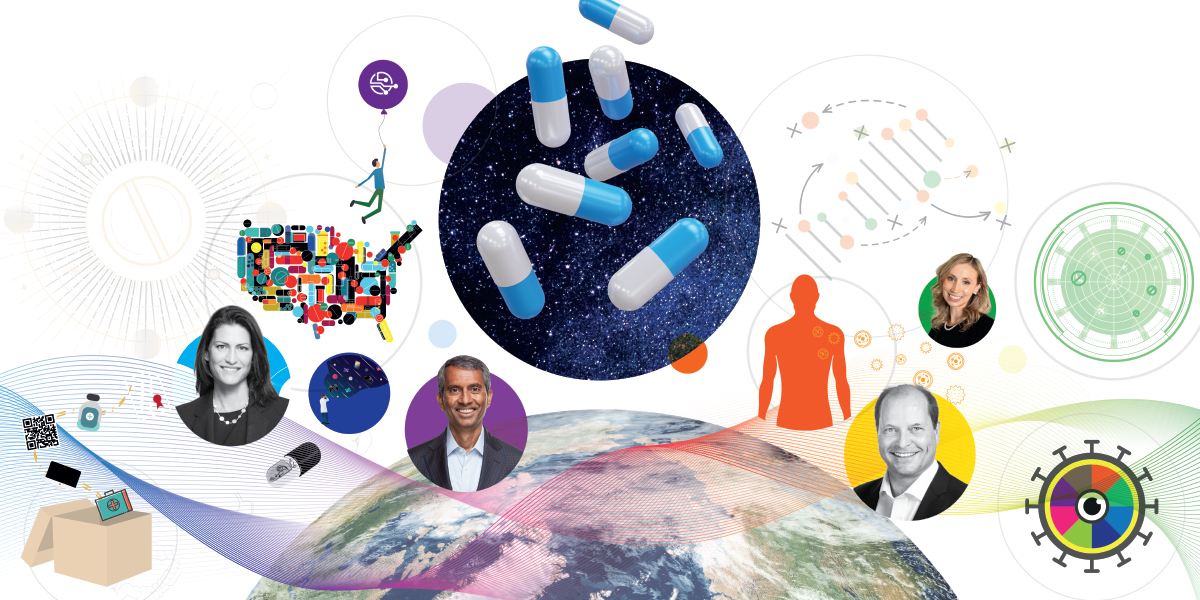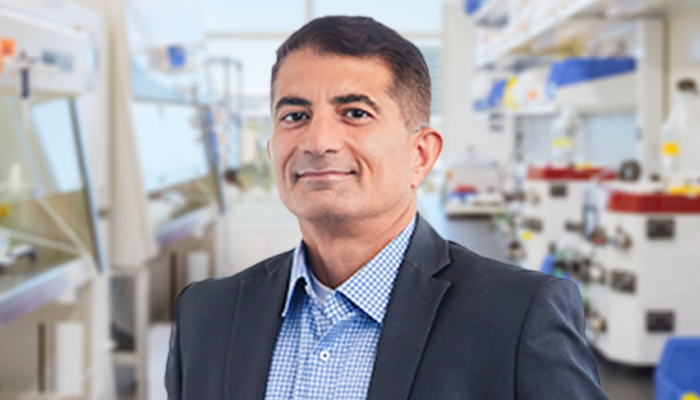The Multifaceted Future of Pharma – Chapter 5: Betting on Biopharma and Better Bioprocessing
From sustainability to automation, here’s what the future of biopharma could look like, according to experts.
Automation, conjugation, and collaboration have all contributed to the augmentation of biopharmaceutical manufacturing in the ten years since the launch of The Medicine Maker. But what factors will drive change and propel innovation over the next ten years? We asked a range of experts from the sector.
We asked: What has/have been the key disruptor(s) driving the industry over the past ten years, and how will this change in the next 10 years?

“The key disruption in the pharma industry has been the rise of biologics and their increasing relevance compared to small molecules. The first generation were protein-based therapies like monoclonal antibodies, which have demonstrated their therapeutic potential in a variety (and growing list) of indications – from oncology to immunology and several rare diseases.
“This wave created a variety of blockbuster molecules and gave rise to the bioprocessing industry, as therapeutic manufacturers were in need of purpose-built products to effectively manufacture these therapies. In particular, the emergence of single use as a technology fundamentally changed the manufacturing paradigm. The next wave of innovation created cell and gene therapies in the 2010s. During COVID, mRNA, another new modality, demonstrated its potential in the rapid design and production of vaccines.
“Over the next 10 years, we will see this trend to continue, rooted in deep pipeline funnels and sustained R&D spend and funding. mAbs will maintain the lion’s share of the Biologics market, but a variety of novel modalities will continue to grow, effectively complementing the treatment options for patients. From a manufacturing perspective, two trends will likely continue: (i) increasing adoption of intensified processing for a more robust, cost-effective way of producing mAbs without compromising on quality, and (ii) the establishment of new manufacturing templates that are needed to make novel modalities, like viral gene therapies, more broadly accessible.”

“The biopharmaceutical industry has been shaped by several key disruptors, particularly in the field of genetic medicine. While adeno-associated virus (AAV) vectors have brought genetic medicines to patients with rare and often fatal diseases, the challenges associated with the in vivo delivery of genetic medicine technologies have left many without safe and effective treatment options. Major challenges of AVVs include the need for high doses, expensive manufacturing, and the potential for adverse side effects – such as liver toxicity. Additionally, pre-existing antibodies to conventional vectors limit the utility of these therapies.
“The field needs vectors that are more efficient at transducing specific cell types, and vectors that are more efficiently delivered at low and safe doses by routine routes of administration clinically; simply, we need better vectors. I foresee a shift in the introduction and development of next-generation AAVs using synthetic biology and novel capsids to overcome the limitations of conventional AAVs across the next ten years. One widely recognized approach that could bring superior AAV vectors is directed evolution, which allows humans to create novel bespoke biologics. In the case of AAV, the capsid can be diversified in order to generate billions of potential synthetic AAV capsids. In vivo iterative selection can then be used to identify the synthetic AAV capsid with the best match to the investigator’s target vector profile.
“Though past successes focused predominantly on rare diseases, the industry's gaze now appears set on larger, more complex conditions. As such, we might also expect to see breakthroughs in delivery systems, as enhancements in vector design, transgenes, and immunomodulatory regimens will likely improve delivery efficiency and gene expression, and reduce immunogenicity.”

“We’ve witnessed antibody-based therapeutics transform the treatment landscape for patients across autoimmune disease, infectious disease, and especially cancer. Monoclonal antibodies have drastically improved patient outcomes in oncology and become the backbone for a range of therapeutic strategies. Their ability to bind specific targets continues to offer near limitless applications across drug development.
“We’re now entering the “antibody 2.0” era, wherein the field has begun to overcome the initial limitations of antibody-based therapeutics, such as efficacy and resistance. We’ve seen the adoption of new strategies in the form of antibody-conjugates, which are quickly becoming the norm, and now bispecific antibodies are emerging as another breakthrough drug class. These drugs can function as a combination treatment in a single molecule, simultaneously reducing toxicities associated with multidrug regimens and decreasing the likelihood of resistance. The high specificity of bispecifics can be combined not only with ADCs, but an array of other treatment modalities to enhance on-target activity and reduce side effects. The incredible flexibility of this approach is already creating new therapeutic strategies and improving on existing approaches.
“With the growing number of applications, I foresee a concurrent rise in investment and collaboration aimed at streamlining antibody design and manufacturing, enabling us to treat patients with safer, more potent therapeutics.”
“Bioprocessing has played and continues to play an essential role in the life sciences. By providing the materials needed to fuel the revolution in next-generation therapies, cell and gene therapies and biologics have come to the forefront of disease treatment. Ever increasing demand for these therapies is continuing to push our industry to develop more optimized workflows capable of ensuring consistent and cost effective, large-scale drug substance manufacturing. At the same time, mounting global awareness and necessary pressure to develop environmentally sustainable processes is pushing our sector to innovate faster than ever.
“When it comes to sustainability, one of the most crucial areas is single-use technologies (SUTs). Thermoplastic-based SUTs are widely recognized as essential for supporting the evolving bioprocessing sector, and more broadly within healthcare. Owing to the significant risks that contamination poses in bioprocessing, SUTs have rapidly become the gold standard of mitigating these risks. However, they pose an apparent challenge when considering environmental impact as they, by definition, create a visible wastestream.
“As the industry continues to transform, we can see a shift in perspective – companies taking a more holistic approach to integrating sustainability practices to minimize environmental impact wherever possible, whilst maximizing innovation to meet global healthcare demands. For example, SUTs offer clear benefits over more permanent, reuseable equipment solutions as they reduce the need for on-site cleaning and sterilization that, in an industrial setting, can require huge amounts of water and energy – both of which contribute significant amounts of waste of their own.
“Already, it is motivating to see how the industry is responding to these discussions and investing in appropriate solutions. Methods currently being employed include repurposing waste for energy production, or recycling scrap materials into usable products such as plastic lumber. In the coming years, I believe we will continue to see the development of new and exciting strategies to push this further, as well as the emergence of cutting-edge instruments and technologies built with efficiency and environmental impact at their core.”

“One change that could dramatically improve the biopharmaceutical industry is the increase of collaboration and partnerships through strategic deal making. Partnerships are vital to our industry, especially during economic downturns when the IPO window closes. Despite 2021 and 2022 being quieter for dealmaking and the biotech IPO market falling 93 percent from 2021, deal volume across the pharma and life sciences sector was up 20 percent in mid-May of 2024 over the previous year period. Furthermore, as of mid-July this year, 13 of the 26 acquisitions worth at least $50 million in upfront value were of private biotechs, surpassing the pace set in each of the previous six years. This underscores the potential for our industry to advance, even in challenging fiscal times, and the important role strategic collaborations will play in its advancement.”

“Regardless of the manufacturing path, one transformative improvement that could dramatically elevate the biopharmaceutical industry is the adoption of modular manufacturing defined by product attributes rather than the manufacturing process. This not only optimizes existing therapies, but paves the way for rapid production of new, emerging therapies.
“This approach focuses on critical quality attributes and process parameters that define the product’s efficacy, safety, and quality. This method ensures that the final product meets its intended quality and efficacy standards, allowing for more dynamic and adaptable manufacturing processes.
“In addition, the manufacturing process can be broken into modular units that can each be validated for specific attributes. These manufacturing modules can be reconfigured or replaced if needed, providing greater flexibility and efficiency. Modular manufacturing allows for rapid adaptation to new therapies and changes in production needs, which is particularly beneficial for personalized medicines and rapidly evolving treatment modalities. This method provides a holistic and integrated approach to validation, with process and product data flows as the foundation.
“Transitioning to attribute-based validation and modular manufacturing represents a paradigm shift for the pharmaceutical industry. We can unlock significant manufacturing productivity, enhance flexibility, and drive down costs – making these new treatment options accessible to more patients.
“In addition, something else I would like to see in drug development and manufacturing is as much standardization as possible around novel therapies. Wherever possible, platform processes and standardized raw materials and consumables should be employed to reduce complexity, accelerate manufacturing timelines and reduce costs. In addition, I would like to see clear and consistent regulatory standards for new modalities, balancing safety and the unique aspects of these therapies, such as production processes and efficacy definitions.
“Together, these changes would improve patient outcomes and advance the industry as a whole.”

“One thing that could dramatically change the pharmaceutical industry would be to adopt the lessons we learned during the pandemic around collaboration.
“To that end, BioPhorum Supply Resilience is scoping out a “crisis response team” to proactively manage industry readiness and response from “detection to escalation” of any future crises impacting our biopharmaceutical manufacturing industry.
“The question is, how can we act collectively? There is a need today for a consistent voice that’s representative of all major biopharma agencies, but separate from the guidance of the pharmaceutical industry – because our production processes and requirements are so starkly different, all the way down to the molecule.
“For example, during the COVID-19 pandemic, 182 separate vaccine projects were initiated. When similar events occur in the future, we must be able to work with agencies and organizations such as CEPI, GAVI, and the WHO to collectively decide how many projects receive approval, and prioritize supply efficiently.
“As the WHO Director-General Tedros Adhanom Ghebreyesus puts it, ‘The world must be ready to respond to the next pandemic. When the next pandemic comes knocking — and it will — we must be ready to answer decisively, collectively, and equitably.’”

We asked: What big changes in drug development and manufacturing would you like to see in the next 10 years?
“It would be great to see molecules being designed and produced in a faster, cheaper, safer, and less resource- and energy-intensive way.
“Standardization of single-use technologies can help in this regard, alongside greater fluid control and automation. Over the next 10 years, consensus bodies such as ASTM International may narrow their standards for specifications and testing, leading to more stringent, harmonized methods for single-use components. However, the fast-paced and evolving nature of the bioprocessing industry makes it difficult to keep up with standardization. Therefore, close interaction between all stakeholders will be required.
“The biopharmaceutical industry has evolved from large-scale facilities with fixed stainless-steel tanks to flexible and modular plants that use disposable bioprocessing equipment. This shift has significantly reduced the costs associated with energy, water, and cleaning chemicals, while accelerating time to market. These technologies are already an integral part of today’s biomanufacturing landscape and will see their next big change, by fully integrating single use into advanced fluid control and process automation. Such smart integrated systems enable precise control and monitoring of process fluid characteristics, such as temperature, velocity, filling volume, pressure at filters, etc. The ability to precisely control and monitor the fluid within the single use components will greatly reduce process risk and product loss.
“Automation combined with process intensification will undoubtedly have a significant impact on the industry. Over the next 10 years, biomanufacturers will need to be open to implementing highly automated process intensification strategies for seed train expansion, such as optimizing media and strains through automated high-throughput screening, high cell density cultivation and automated aliquoting, as well as the controlled freezing of large single use cryobags. Additionally, advances in automation and robotics will improve manufacturing efficiency, reduce human error, and increase throughput.”

With technology advancing at an unprecedented pace, the drug development industry has made significant strides in addressing inefficiencies. However, manufacturing remains a significant barrier to making new therapies widely accessible. Low productivity, lengthy production timelines, high cost of goods manufactured (CoGm), and challenges in characterizing complex products continue to be major obstacles, particularly in the manufacturing of advanced therapies,
While most approved AAV-based gene therapies have achieved scientific and clinical success, commercial success can be elusive because of prohibitively high price points. To overcome these challenges and reduce costs, companies must focus on advancing both product and process design technologies. Additional challenges include ensuring therapeutic durability and mitigating immunotoxicity, particularly in the development of viral vectors for genetic medicines. Even the most promising therapies can fail if neutralized by an immune response, if the payload is not accurately delivered to the target, or if production cannot be robustly scaled.
Simplification of product constructs through novel vector design approaches, coupled with advanced manufacturing technologies, has the potential to dramatically lower CoGs, enhance productivity, and thereby maximize patient accessibility. Further benefits include opportunities for platform standardization, improved product and process understanding, and consistent, high-quality output.
Over the past century, production processes for small-molecule drugs have matured significantly, allowing for the large-scale manufacturing of even complicated organic molecules efficiently and at low cost. Notably, 2010 was the last year when all the top ten drugs were small molecules. The introduction of Humira and other antibody-based drugs shifted the trillion-dollar pharmaceutical business from a chemical to a biological industry almost overnight. In the 2023 top ten list, only two of the top ten drugs were small molecules (Eliquis and Biktarvy). Instead, biologics now dominate the drug market, with six of the top ten drugs being antibodies, one being RNA, and one a peptide. The upcoming waves of future drugs are predominantly biologics as well, with acronyms like BsAbs, CAR-T, AAV, TCR, ADC, and many more on the horizon.
However, the cost, speed, consistency, and complexity of biologics manufacturing lag far behind those of small-molecule chemistry manufacturing. Biological production systems are inherently unstable because of evolutionary factors, an abundance of epistatic variables complicating predictability, and the large number of atoms in each drug molecule complicating consistency and homogeneity.
There is an urgent need for the biotechnology industry to implement standardization, data tracking, and statistical engineering tools from the design all the way to the manufacturing of biologics. While AI has been a major discussion point since the 2022 release of ChatGPT, no amount of NVIDIA chips and multi-node neural nets can help if the underlying functional data is missing, poorly distributed in multidimensional space, or prone to non-systematic variance. Over the next few years, the drug development and manufacturing industry should focus on designing systematic experiments and data capture in an integrated platform to efficiently seize biological sequence-function space to generate new and improved biologics and manufacturing processes.

“I would like to see players in the biopharma industry go beyond merely advancing their business goals. This means facilitating more robust partnerships and working as one team to expedite the development/commercialization of novel therapeutics.
“Acknowledging that monoclonal antibodies make up the largest share in the industry and are still the fastest-growing modality in the market, efforts to mitigate side effects while taking chemotherapeutics have long hit roadblocks. The successful clinical result of Daiichi Sankyo’s Enhertu in 2022 has propelled hope that soon such roadblocks can be overcome by developing more types of drug conjugates beyond antibodies. To bring the hope to fruition, industry-wide efforts to leverage conjugation methods to bring about novel therapeutics are well underway.
“For example, Regeneron's AAV conjugation antibody reduces side effects from off-target expression and seeks to deliver AAV to target cells. Such innovative therapeutics can become available if more robust conjugation methods that send payloads to specific cells with little side effects can be developed. I hope to see more rigorous efforts to create pipelines that can conjugate other types of payloads, such as radioactive materials, steroids, and cytotoxic drugs.
“To embolden such efforts, the industry players need to come together and collaborate. ADCs need cutting-edge technologies and advanced facilities. Not all drug developers have such resources available and thus need help. This is why I hope to see more partnerships between drug developers with scientific knowledge and CDMOs with resources in the future, filling each other’s gap and doubling down on our concerted mission for patients.”